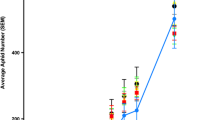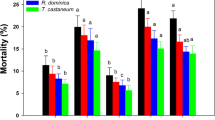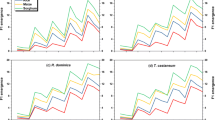Abstract
We investigated the influence of the Fusarium mycotoxin deoxynivalenol on the English grain aphid Sitobion avenae (Hemiptera: Aphididae) and its parasitic wasp Aphidius ervi (Hymenoptera: Braconidae) using in vitro laboratory experiments. In this tritrophic interaction, deoxynivalenol caused lethal (declined survival) and sublethal (prolonged nymphal development and reduced reproduction) effects on S. avenae aphids and consequentially led to a decreased production of parasitoid offspring resulting from parasitized deoxynivalenol-contaminated aphids. This paper highlights that the presence of mycotoxins should be considered in environmental risk assessment tests because they may alter the efficiency of biological control agents such as parasitoids through food chain contamination.

Similar content being viewed by others
References
Al Dobai S, Praslicka J, Mistina T (1999) Parasitoids and hyperparasitoids of cereal aphids (Homoptera, Aphididae) on winter wheat in Slovakia. Biologia 54:573–580
Audenaert K, Van Broeck R, Bekaert B, De Witte F, Heremans B, Messens K, Hofte M, Haesaert G (2009) Fusarium head blight (FHB) in Flanders: population diversity, inter-species associations and DON contamination in commercial winter wheat varieties. Eur J Plant Pathol 125:445–458
Barbosa P, Gross P, Kemper J (1991) Influence of plant allelochemicals on the tobacco hornworm and its parasitoid, Cotesia congregata. Ecology 72:1567–1575
Barczak T, Debek-Jankowska A, Bennewicz J (2014) Primary parasitoid and hyperparasitoid guilds (Hymenoptera) of grain aphid (Sitobion avenae F.) in northern Poland. Arch Biol Sci 66:1141–1148
Benjamini Y, Hochberg Y (2000) On the adaptive control of the false discovery fate in multiple testing with independent statistics. J Educ Behav Stat 25:60–83
Bennett JW, Klich M (2003) Mycotoxins. Clin Microbiol Rev 16:497–516
Bottalico A, Perrone G (2002) Toxigenic Fusarium species and mycotoxins associated with head blight in small-grain cereals in Europe. Eur J Plant Pathol 108:611–624
Bukovinszky T, Gols R, Smid HM, Kiss GB, Dicke M, Harvey JA (2012) Consequences of constitutive and induced variation in the host’s food plant quality for parasitoid larval development. J Insect Physiol 58:367–375
Bultman TL, Rodstrom JL, Radabaugh KR, VanDop JD, Librizzi JM, Longwell LL, Pulas C, Grant L, Sullivan TJ (2009) Influence of genetic variation in the fungal endophyte of a grass on an herbivore and its parasitoid. Entomol Exp Appl 130:173–180
Cai QN, Han Y, Cao YZ, Hu Y, Zhao X, Bi JL (2009) Detoxification of gramine by the cereal aphid Sitobion avenae. J Chem Ecol 35:320–325
Campbell BC, Duffey SS (1981) Alleviation of alpha-tomatine-induced toxicity to the parasitoid, Hyposoter exiguae, by phytosterols in the diet of the host, Heliothis zea. J Chem Ecol 7:927–946
Cardoza YJ, Teal PEA, Tumlinson JH (2003) Effect of peanut plant fungal infection on oviposition preference by Spodoptera exigua and on host-searching behavior by Cotesia marginiventris. Environ Entomol 32:970–976
Castaneda LE, Figueroa CC, Nespolo RF (2010) Do insect pests perform better on highly defended plants? Costs and benefits of induced detoxification defences in the aphid Sitobion avenae. J Evol Biol 23:2474–2483
Claudianos C, Ranson H, Johnson RM, Biswas S, Schuler MA, Berenbaum MR, Feyereisen R, Oakeshott JG (2006) A deficit of detoxification enzymes: pesticide sensitivity and environmental response in the honeybee. Insect Mol Biol 15:615–636
Daza-Bustamante P, Fuentes-Contreras E, Niemeyer HM (2003) Acceptance and suitability of Acyrthosiphon pisum and Sitobion avenae as hosts of the aphid parasitoid Aphidius ervi (Hymenoptera: Braconidae). Eur J Entomol 100:49–53
De Zutter N, Audenaert K, Haesaert G, Smagghe G (2012) Preference of cereal aphids for different varieties of winter wheat. Arthropod Plant Interact 6:345–350
Fornelli F, Minervini F, Mule G (2004) Cytotoxicity induced by nivalenol, deoxynivalenol, and fumonisin B, in the SF-9 insect cell line. In Vitro Cell Dev Biol Anim 40:166–171
Gols R (2014) Direct and indirect chemical defences against insects in a multitrophic framework. Plant, Cell Environ 37:1741–1752
Goswami RS, Kistler HC (2004) Heading for disaster: Fusarium graminearum on cereal crops. Mol Plant Pathol 5:515–525
Grove JF, Hosken M (1975) Larvicidal activity of some 12,13-epoxytrichothec-9-enes. Biochem Pharmacol 24:959–962
Harri SA, Krauss J, Muller CB (2008) Fungal endosymbionts of plants reduce lifespan of an aphid secondary parasitoid and influence host selection. Proc R Soc B Biol Sci 275:2627–2632
Harri SA, Krauss J, Muller CB (2009) Extended larval development time for aphid parasitoids in the presence of plant endosymbionts. Ecol Entomol 34:20–25
Harvey JA, Van Dam NM, Witjes LMA, Solerro R, Gols R (2007) Effects of dietary nicotine on the development of an insect herbivore, its parasitoid and secondary hyperparasitoid over four trophic levels. Ecol Entomol 32:15–23
Isebaert S, De Saeger S, Devreese R, Verhoeven R, Maene P, Heremans B, Haesaert G (2009) Mycotoxin-producing Fusarium species occurring in winter wheat in Belgium (Flanders) during 2002–2005. J Phytopathol 157:108–116
Joseph JR, Ameline A, Couty A (2011) Effects on the aphid parasitoid Aphidius ervi of an insecticide (Plenum (R), pymetrozine) specific to plant-sucking insects. Phytoparasitica 39:35–41
Kang Z, Buchenauer H (1999) Immunocytochemical localization of Fusarium toxins in infected wheat spikes by Fusarium culmorum. Physiol Mol Plant Pathol 55:275–288
Landschoot S, Audenaert K, Waegeman W, De Baets B, Haesaert G (2013) Influence of maize-wheat rotation systems on Fusarium head blight infection and deoxynivalenol content in wheat under low versus high disease pressure. Crop Prot 52:14–21
Lu Y, Gao X (2009) Multiple mechanisms responsible for differential susceptibilities of Sitobion avenae (Fabricius) and Rhopalosiphum padi (Linnaeus) to pirimicarb. Bull Entomol Res 99:611–617
Mule G, Dambrosio A, Logrieco A, Bottalico A (1992) Toxicity of mycotoxins of Fusarium sambucinum for feeding in Galleria mellonella. Entomol Exp Appl 62:17–22
Oakeshott JG, Johnson RM, Berenbaum MR, Ranson H, Cristino AS, Claudianos C (2010) Metabolic enzymes associated with xenobiotic and chemosensory responses in Nasonia vitripennis. Insect Mol Biol 19:147–163
Ode PJ, Berenbaum MR, Zangerl AR, Hardy ICW (2004) Host plant, host plant chemistry and the polyembryonic parasitoid Copidosoma sosares: indirect effects in a tritrophic interaction. Oikos 104:388–400
Pan MZ, Liu TX (2014) Suitability of three aphid species for Aphidius gifuensis (Hymenoptera: Braconidae): parasitoid performance varies with hosts of origin. Biol Control 69:90–96
Pestka JJ (2010) Toxicological mechanisms and potential health effects of deoxynivalenol and nivalenol. World Mycotoxin J 3:323–347
Pradeep FS, Palaniswamy M, Ravi S, Thangamani A, Pradeep BV (2015) Larvicidal activity of a novel isoquinoline type pigment from Fusarium moniliforme KUMBF1201 against Aedes aegypti and Anopheles stephensi. Process Biochem 50:1479–1486
Prosser WA, Douglas AE (1992) A test of the hypotheses that nitrogen is upgraded and recycled in an aphid (Acyrthosiphon pisum) symbiosis. J Insect Physiol 38:93–99
Rocha O, Ansari K, Doohan FM (2005) Effects of trichothecene mycotoxins on eukaryotic cells: a review. Food Addit Contam 22:369–378
Roth S, Knorr C, Lindroth RL (1997) Dietary phenolics affects performance of the gypsy moth (Lepidoptera: Lymantriidae) and its parasitoid Cotesia melanoscela (Hymenoptera: Braconidae). Environ Entomol 26:668–671
Sadd BM et al (2015) The genomes of two key bumblebee species with primitive eusocial organization. Genome Biol 16:76–107
Sadeghi A, Van Damme EJM, Smagghe G (2009) Evaluation of the susceptibility of the pea aphid, Acyrthosiphon pisum, to a selection of novel biorational insecticides using an artificial diet. J Insect Sci 9:1–8
Tomanovic Z, Kavallieratos NG, Stary P, Petrovic-Obradovic O, Athanassiou CG, Stanisavljevic LZ (2008) Cereal aphids (Hemiptera: Aphidoidea) in Serbia: seasonal dynamics and natural enemies. Eur J Entomol 105:495–501
van Nouhuys S, Laine AL (2008) Population dynamics and sex ratio of a parasitoid altered by fungal-infected diet of host butterfly. Proc R Soc B Biol Sci 275:787–795
Werren JH et al (2010) Functional and evolutionary insights from the genomes of three parasitoid nasonia species. Science 327:343–348
Wyatt IJ, White PF (1977) Simple estimation of intrinsic increase rates for aphids and tetranychid mites. J Appl Ecol 14:757–766
Zhang MX, Fang TT, Pu GL, Sun XQ, Zhou XG, Cai QN (2013) Xenobiotic metabolism of plant secondary compounds in the English grain aphid, Sitobion avenae (F.) (Hemiptera: Aphididae). Pest Biochem Physiol 107:44–49
Acknowledgments
Nathalie De Zutter is holder of a Ph.D. grant by the Institute for the Promotion of Innovation by Science and Technology in Flanders (IWT mandate No 111432).
Author information
Authors and Affiliations
Corresponding author
Additional information
Handling Editor: Robert Glinwood.
Geert Haesaert and Guy Smagghe are equal last author.
Rights and permissions
About this article
Cite this article
De Zutter, N., Audenaert, K., Ameye, M. et al. Effect of the mycotoxin deoxynivalenol on grain aphid Sitobion avenae and its parasitic wasp Aphidius ervi through food chain contamination. Arthropod-Plant Interactions 10, 323–329 (2016). https://doi.org/10.1007/s11829-016-9432-1
Received:
Accepted:
Published:
Issue Date:
DOI: https://doi.org/10.1007/s11829-016-9432-1




